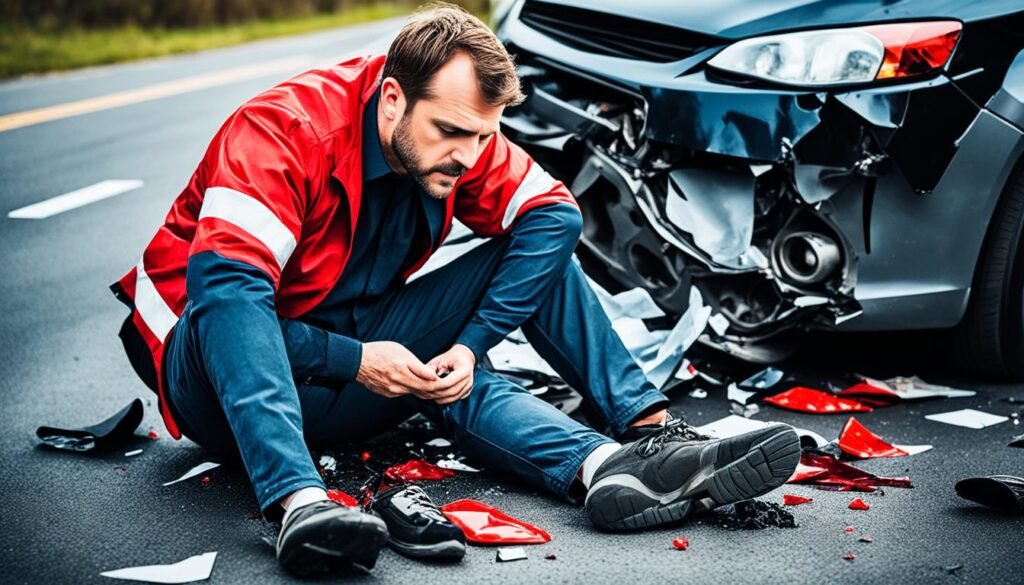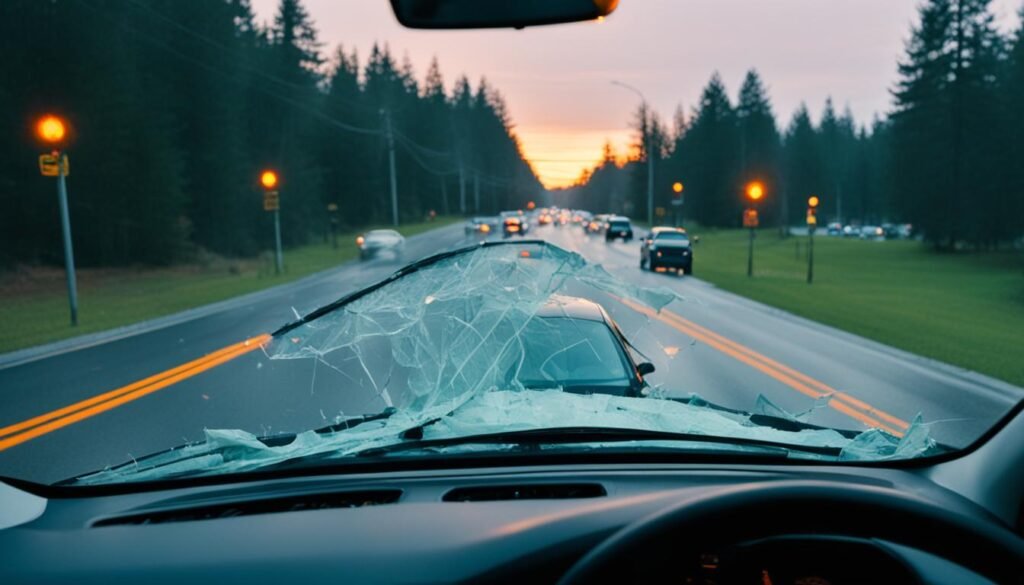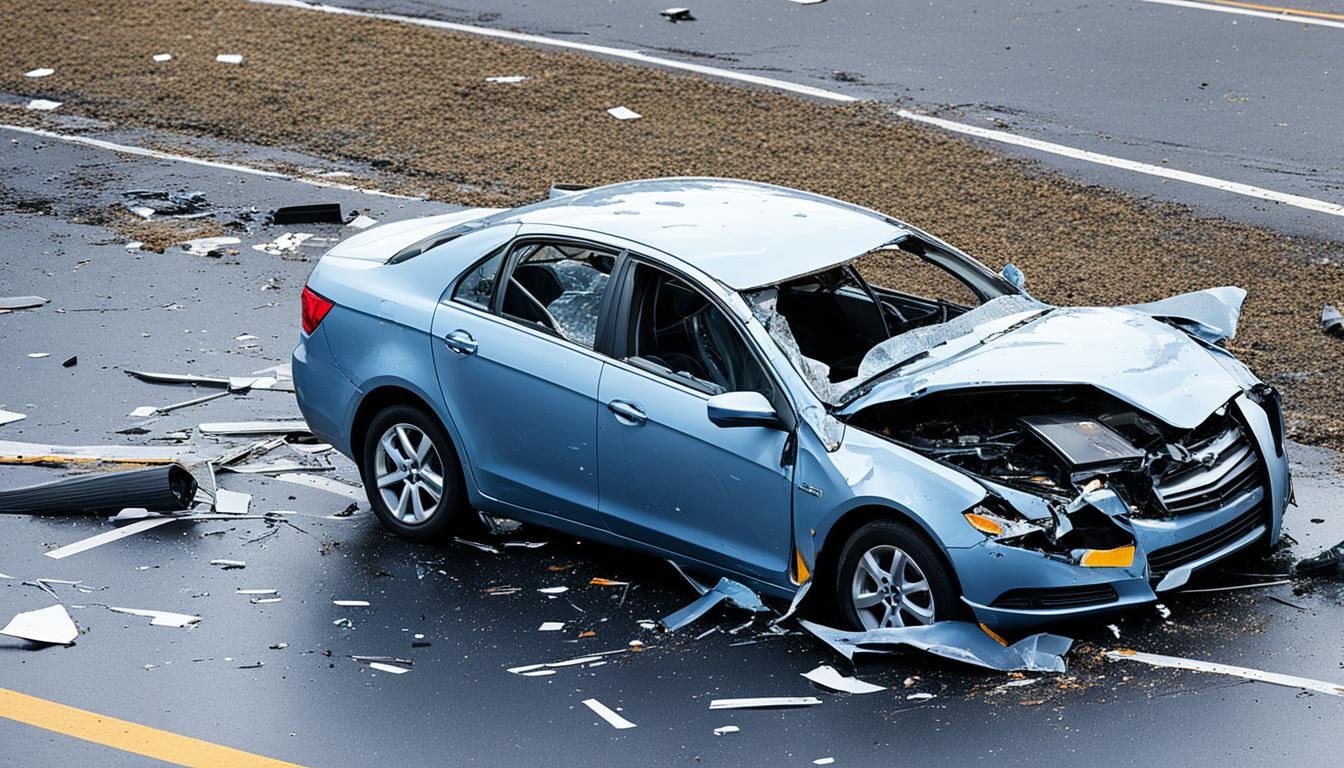Every year, about 6 million car accidents happen in the United States. It’s a big number, showing why it’s crucial to know what to do after a car accident. Whether you’re involved in a small crash or a big wreck, the right steps can safeguard you legally and financially. We’ll guide you through what to do after a car wreck. This guide gives you steps to ensure you’re protected.
Key Takeaways:
- Knowing what to do after a car accident can help protect you legally and financially.
- Check for injuries and call emergency services if necessary.
- Move your vehicles to a safe location to prevent further accidents.
- Exchange information with the other driver involved in the accident.
- Document the accident scene by taking pictures of vehicle damage and road conditions.
Step 1: Check for Injuries and Call for Help
After a car accident, your first step should be to check for injuries. Make sure you and others are okay. Look for any signs of injury, no matter how small.
Even minor symptoms like pain or dizziness are important. They could mean something more serious.
If someone is hurt, call 911 right away. Report the accident and ask for medical help. Even small injuries should be checked by a professional.

Getting medical help does two things. It makes sure you’re okay and it documents your injuries. This is important for insurance or legal issues later.
Quickly dealing with injuries and calling 911 helps everyone get the care they need. It also helps with recovering after the accident. Next, we will cover more safety steps and legal actions to consider.
Car Accident Injuries: What to Look Out For
Car accidents can cause many injuries, from small to serious. Common injuries include:
- Whiplash
- Back and neck injuries
- Head injuries and concussions
- Bone fractures
- Cuts and lacerations
- Internal injuries
- Soft tissue injuries
It’s important to get medical help right away if you notice any symptoms after an accident.
| Emergency Response | Safety After an Accident | Medical Attention |
|---|---|---|
| Calling 911 | Moving to a safe location | Checking for injuries |
| Seeking medical attention | Exchanging information with the other driver | Documenting the accident scene |
| Receiving proper care and treatment | Taking pictures of vehicle damage |
Step 2: Move to a Safe Location
After making sure everyone is safe and calling for help, moving the cars is crucial. This is very important if you’re on a busy road. Moving the cars keeps further accidents from happening and lets you safely share info with the other driver.
Getting your vehicles out of the way cuts down on the risk of more crashes. It keeps everyone safer. When moving the cars, be very careful. Turn on your blinkers to let other drivers know what’s happening. This keeps everyone involved safe and alerts drivers to be cautious.
The aim is to make a secure spot for everyone. By moving the cars and using blinkers, you’re helping to avoid more risks. It helps everyone exchange details smoothly.

Safety Precautions When Moving Vehicles After an Accident:
- Check for any fluid leaks or visible damage that could hinder vehicle movement.
- Use extreme caution when exiting your vehicle and while moving around the accident scene.
- Assess the traffic conditions and wait for a safe gap to merge into traffic.
- Avoid blocking traffic lanes or obstructing the flow of vehicles.
- Communicate with the other driver to coordinate a safe movement of the vehicles.
Following these steps ensures your safety and helps keep the road safe. It makes the after-accident process easier.
| Common Safety Tips After Moving Vehicles | Additional Considerations |
|---|---|
| Turn on your hazard lights to alert other drivers. | Check for any hidden injuries and provide assistance if needed. |
| Place warning devices, like reflective triangles, if available. | Exchange contact and insurance information with the other driver. |
| Stay calm and avoid engaging in confrontation with the other driver. | Take photos of the accident scene and any visible damages. |
Step 3: Exchange Information with the Other Driver
Once the vehicles are in a safe spot, swap info with the other driver. This is a key step to handle what comes next and make things go smoothly.
Start by sharing your contact info with the other driver. Give them your name, phone number, and email. Then, ask for theirs. You’ll need this for talking about insurance or any legal stuff that might come up.
Then, swap insurance details. Tell them your insurance company’s name and your policy number. Get their info too. This helps both of you start the claim process and take care of any costs from damage or injuries.
Also, write down the other driver’s license plate number. It’s good for knowing who they are and for making a clear record of the accident.
When you’re swapping info, stay calm and be polite. Just focus on getting the details you need. Don’t argue, say it was your fault, or guess why the accident happened. Just stick to the facts and share what is needed for the paperwork and what comes next.
Exchanging the right info after a car crash is key to solving legal and money issues. Sharing contact and insurance details, plus license plate numbers, helps everyone talk and handle claims or legal stuff properly.
Example of Contact Information Exchange:
| Your Information | Other Driver’s Information |
|---|---|
| Your Name: John Smith | Their Name: Jane Doe |
| Your Phone Number: (555) 123-4567 | Their Phone Number: (555) 987-6543 |
| Your Email: john.smith@example.com | Their Email: jane.doe@example.com |
| Your Insurance Company: ABC Insurance | Their Insurance Company: XYZ Insurance |
| Your Policy Number: 123456789 | Their Policy Number: 987654321 |
| Your License Plate Number: ABC123 | Their License Plate Number: XYZ789 |
Be sure to keep this info correct and safe. It makes the claim and any legal steps smoother.
Step 4: Take Pictures of the Accident Scene
After making sure everyone is safe and exchanging info with the other driver, taking pictures is key. These photos are vital evidence for your case. They help show who was at fault.
First, focus on taking clear photos of all vehicles involved. Show any damage from various angles. Capture close-ups of dents, scratches, or broken parts. These images record the damage for insurance or court.
Also, take photos of the road and area around the accident. Include skid marks, hazards, or bad lighting. These help paint a full picture of the accident scene. They show how the incident happened.
Photos are strong evidence for your case. To make them count, take many from different views. Use daylight if you can. Make sure not to block the view. Documenting everything improves your chance for a fair deal or winning in court with a lawyer’s help.

